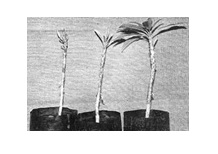
Air-layering:
------------
Air layering is carried out in the month of June. In this method a 1-2 year old, healthy, vigorous, mature shoot of 45-60 cm in length and pencil thickness is selected. A circular strip of bark about 3 cm wide just below a bud is completely removed from the selected shoot. Rooting hormones like IBA & NAA 50mg each in Lanoline paste are applied over this portion. Moist sphagnum moss is packed around this portion and tied with polyethylene sheet to prevent the loss of moisture. Application of such hormones promotes early rooting. Light brown roots are visible through the polythene wrap within 4 months. The rooted shoot is slowly detached by giving 2-3 successive cuts over a period of week before finally detaching from the parent plant. These are planted in pots and kept in nursery under shade. Top of the shoot is cut back to maintain a proper ratio of leaves: roots.
Sapota plants prepared from air-layering are susceptible to damage by strong winds and cannot withstand drought, as their root system does not penetrate very deep into the soil.
Approach Grafting:
-----------------
In this method 2-3 year old `Khirni` or `Rayan` plants raised in polythene bags are used as rootstocks due to their strong root system. These seedlings should be atleast 45-60cm in height and 1 cm in diameter at the time of grafting.
Approach grafting should be preferably done in the beginning of rainy season or during February-March. However grafting during February-March is more economical as the grafts will have to be maintained in nursery for a shorter period of time. The success rate of the grafts is also high as compared to those obtained in rainy season.
The mother plants selected for approach grafting should be vigorous true-to-type and between 10-15 years old. The lower most branches are usually bent and tied to a peg near the ground. 1-11/2 year old branch (scion) of pencil thickness is selected for grafting. The seedling of `Khirni` (rootstock) is brought closer to the branch near the ground. The cambium layers of one side of this plant at 10-15cm from the base of the plant is exposed by taking a 5-6cm long and 0.5cm wide cut with a sharp knife. Similar cut is taken on the selected branch of the mother plant. The exposed portion of bot the plants are brought together and secured firmly with polythene strip. Care should be taken to avoid gap between the joints.
The union of the scion and the stock takes place in about 2-21/2 months. However, the scion should not be separated for atleast 3-4 months. During this period the `Khirni` plant should be watered every day for the first 15 days and thereafter, at an interval of 3 days till the graft is separated from the mother plant. The rooted graft is slowly detached by giving 2-3 successive cuts 2cm below the union over a period of month before finally detaching from the parent plant. The grafts are maintained in a nursery under shade for few days.
Soft-Wood Grafting:
------------------
The technique of soft-wood grafting is similar to that of cleft or wedge grafting. The scion should be a terminal non-flowering shoot of 3-4 months maturity with the same thickness as the rootstock. Rootstock of `Ryan` is mostly used for soft-wood grafting. The selected scion should be defoliated while on the mother plant at least 7 days before grafting, keeping a part of petiole intact on the selected shoot. Defoliation prior to grafting helps in swelling of dormant bud of the scion resulting in greater success. In this method, a wedge shaped cut is made on lower part of the scion stick. Similarly 4-6cm long cut is made in the middle portion on the rootstock. The scion stick is then inserted in the cleft of the rootstock and tied with polythene strip. Vigorous sprouting of the scion indicates the successful union of the graft joint. The grafts are further maintained in the shade for sometime before transferring them in the field.

